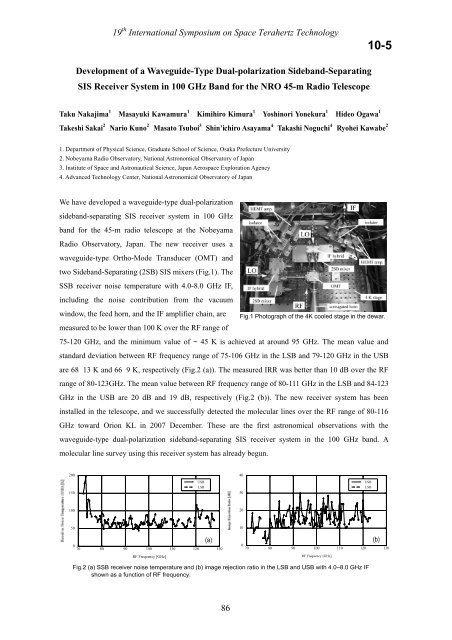Program and Abstract Book - SRON
Program and Abstract Book - SRON
Program and Abstract Book - SRON
Create successful ePaper yourself
Turn your PDF publications into a flip-book with our unique Google optimized e-Paper software.
19 th International Symposium on Space Terahertz Technology<br />
10-5<br />
Development of a Waveguide-Type Dual-polarization Sideb<strong>and</strong>-Separating<br />
SIS Receiver System in 100 GHz B<strong>and</strong> for the NRO 45-m Radio Telescope<br />
Taku Nakajima 1 Masayuki Kawamura 1 Kimihiro Kimura 1 Yoshinori Yonekura 1 Hideo Ogawa 1<br />
Takeshi Sakai 2 Nario Kuno 2 Masato Tsuboi 3 Shin’ichiro Asayama 4 Takashi Noguchi 4 Ryohei Kawabe 2<br />
1. Department of Physical Science, Graduate School of Science, Osaka Prefecture University<br />
2. Nobeyama Radio Observatory, National Astronomical Observatory of Japan<br />
3. Institute of Space <strong>and</strong> Astronautical Science, Japan Aerospace Exploration Agency<br />
4. Advanced Technology Center, National Astronomical Observatory of Japan<br />
We have developed a waveguide-type dual-polarization<br />
sideb<strong>and</strong>-separating SIS receiver system in 100 GHz<br />
b<strong>and</strong> for the 45-m radio telescope at the Nobeyama<br />
Radio Observatory, Japan. The new receiver uses a<br />
waveguide-type Ortho-Mode Transducer (OMT) <strong>and</strong><br />
two Sideb<strong>and</strong>-Separating (2SB) SIS mixers (Fig.1). The<br />
SSB receiver noise temperature with 4.0-8.0 GHz IF,<br />
including the noise contribution from the vacuum<br />
window, the feed horn, <strong>and</strong> the IF amplifier chain, are<br />
measured to be lower than 100 K over the RF range of<br />
75-120 GHz, <strong>and</strong> the minimum value of ~ 45 K is achieved at around 95 GHz. The mean value <strong>and</strong><br />
st<strong>and</strong>ard deviation between RF frequency range of 75-106 GHz in the LSB <strong>and</strong> 79-120 GHz in the USB<br />
are 68 13 K <strong>and</strong> 66 9 K, respectively (Fig.2 (a)). The measured IRR was better than 10 dB over the RF<br />
range of 80-123GHz. The mean value between RF frequency range of 80-111 GHz in the LSB <strong>and</strong> 84-123<br />
GHz in the USB are 20 dB <strong>and</strong> 19 dB, respectively (Fig.2 (b)). The new receiver system has been<br />
installed in the telescope, <strong>and</strong> we successfully detected the molecular lines over the RF range of 80-116<br />
GHz toward Orion KL in 2007 December. These are the first astronomical observations with the<br />
waveguide-type dual-polarization sideb<strong>and</strong>-separating SIS receiver system in the 100 GHz b<strong>and</strong>. A<br />
molecular line survey using this receiver system has already begun.<br />
200<br />
40<br />
150<br />
USB<br />
LSB<br />
30<br />
USB<br />
LSB<br />
100<br />
20<br />
50<br />
10<br />
0<br />
70 80 90 100 110 120 130<br />
RF Frequency [GHz]<br />
0<br />
70 80 90 100 110 120 130<br />
RF Frequency [GHz]<br />
86
















